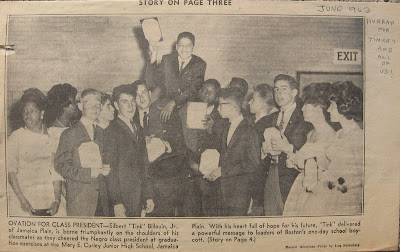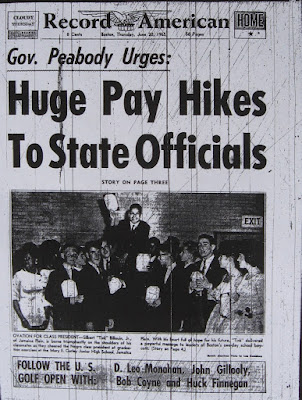 The Daughters of Edward Darley Boit, by John Singer Sargent (Museum of Fine Arts, Boston). Click to enlarge.
The Daughters of Edward Darley Boit, by John Singer Sargent (Museum of Fine Arts, Boston). Click to enlarge.Above, we have one of the treasures of the Museum of Fine Arts in Boston. John Singer Sargent painted the four daughters of Edward D. Boit in Paris in 1882. The girls didn't live in Jamaica Plain, but their father did. Before I knew of this painting, I knew minimal details of the Boits' connection to Jamaica Plain, but the remarkable family portrait above begs attention. To tell the story, I'll go back in time, start at the beginning, and return to the girls and the painting later.
The first Boit to come to America was John, born in England in 1733 and arriving in Boston between 1755 and 1760. John Boit became a merchant, dealing in East and West Indian goods, and becoming one of Boston's leading citizens. John Boit's oldest daughter was Hannah, born in 1765. Hannah married Crowell Hatch, whose name will come up in another entry.
After a second marriage, John Boit had more children, including a son John in 1774. At sixteen, this importer's son went to sea aboard a ship owned by Crowell Hatch. The Columbia was to sail around the Horn to the Northwest coast, trade for furs, and sail on to China. He came home after four years, only to return to sea as captain of many voyages.
The second John Boit married Eleanor Jones of Newport Rhode Island in 1799, and had seven children, including five daughters and two sons. Caroline, the second child, was born in Newport and moved to Boston at an early age with the family. In time, she would move to Jamaica Plain, where she lived out her life as a widow. Daughter Harriet and her husband moved to Jamaica Plain as well, living on Centre street near Boylston street. Of particular interest to us will be Edward Darley Boit, the fifth child and second son.
Edward D. Boit was born in 1813, and spent some of his childhood living on Eliot street in Jamaica Plain. His parents bought 2 1/4 acres of land on the east side of Eliot street, just North of today's Brewer street. By this time, John Boit had retired to the merchant life, and he would die in 1829.
The following story comes from the Chronicles of the Boit Family:
"as a little boy, he (Edward D.Boit) learned to navigate Jamaica Pond on a big log, with a soap box atop of it, and with a long pole to drive it. It was his canoe and he an Indian in search of adventures that never failed him. Woods were all about the pond in those days, with only one open place on each side of it in Brookline and Jamaica Plain, where the road for a rod or two ran down into the water, giving horses a chance to drink. He was always as careful as possible to avoid these openings for fear of being seen, but one day as he was poling by the spot where the road touched the pond in Jamaica Plain, the family doctor drove down to water his horse and recognized him on his log. When he reached home that night he got a sound drubbing."
In time, Edward was sent to Charles Greene's school at Centre and Pond streets. Later, he attended Boston Latin school and Harvard College. After a trip to India as supercargo on a ship, he studied law, passed the bar, and in 1839, married Jane Parkinson Hubbard. In time, they had four children: Edward "Ned" Darley, Robert, Jeanie and John.

In 1847, the family bought a house on a 7 acre lot at the corner of Curtis and Scarborough streets (later Forest Hills and Morton streets. See the property marked with the red star on the later map at right). They called their estate Ingleside, and remained there until 1853. The property was later among those annexed for the West Roxbury Park (later Franklin Park), and sat approximately where the Forest Hills entrance to Franklin Park was placed.

After a short time in Boston, in 1854 the family returned to Jamaica Plain, this time moving to Eliot street (photo).Edward Boit left the practice of law, becoming a businessman. The house on Eliot street was sold in 1859, and the family moved again, this time to Glen road. In time the Boits moved south to Georgia, where Edward entered the cotton business. By 1874, the firm followed cotton prices into collapse, and Edward Darley Boit was ruined. Edward and wife Jane would spend their final years living in Newport, Rhode Island, with the support of their son, Edward Jr. Both died in 1890.
Finally, we get to Edward Jr., the Edward Darley Boit of the Sargent painting. He was born in 1840. He would have been seven years old when his parents bought their first home in Jamaica Plain. The next mention I find of him is his graduation from Harvard in 1863. The story has left Jamaica Plain here, and moves us - finally - towards the famous painting that attracted my attention in the first place. A year after graduating from Harvard, Edward married Mary Louisa Cushing, daughter of John Perkins Cushing. Cushing was nephew of the Perkins brothers, James (who built Pinebank at Jamaica Pond) and Thomas. While in business in the China trade with his uncles, Cushing became an extremely wealthy man, later building Belmont, the estate that was so large it gave the Massachusetts town its name. It is said that once when the town tax collectors came to see him, he asked what the total of the years' tax requirement for the town would be, and wrote a check for the full amount.
Edward did enter the bar, but did not practice for long, if it all. He and Mary Louisa, known as Iza, travelled to Europe, and spent much of the rest of their married lives there. During stays in Italy and France, Edward took painting lessons and became a painter. While travelling between Rome, Paris and Boston, the Boits had four daughters: Florence, 1868, Jane, 1870, Mary Louisa, 1874, and Julia, 1878. Edward Darley Boit is now considered more an art patron than an artist. It was his association with John Singer Sargent, who painted both his daughters and his wife, that keeps his name alive for posterity. The Boits met Sargent at a Paris art exhibit, and commissioned him to paint a portrait of their daughters. The painting now sits in the Boston Museum of Fine Arts, together with the same two oversize vases that are seen in the painting.
I am not an art critic, nor even particularly interested in painting as an art, but this work is a treasure of the MFA collection for a reason. If it is a portrait, it is a strange one. It seems like a psychological study, but of the group rather than of the girls as individuals. I think the word unsettling is appropriate for the effect it gives.
The story of the four girls is well known - at least as far as it is known. None of these four wealthy girls ever married, and the two oldest are described as hovering somewhere between eccentric and emotionally or mentally disturbed. As a final note on Edward: three years after the death of his wife in 1894, he remarried. Did the constant travelling of their childhood and the loss of their mother affect the psyche of the girls? Or does their extraordinary portrait make us imagine things about them that were only on the canvas?
While the famous Boit daughters never lived in Jamaica Plain, their families did, in multiple homes over multiple generations. From sea captain to lawyer and businessman to future expatriot artist and patron, the Boits certainly deserve mention when exploring Jamaica Plain's notable residents. The famous painting, a jewel of the Museum of Fine Art's collection, just makes the story all the more interesting.
There is much more to the story of the Boit family. Here is a start for online information:
Chronicles of the Boit Family - download the PDF version to read.
Museum of Fine Arts
Edward Darley Boit
The Harvard Graduates' Magazine
The Washington Historical Quarterly - John Boit's log of his voyage on the ship Columbia. When men were men.
Norfolk Registry of Deeds:
68:45 - 9/30/1822 David Greenough to John Boit, Eliot st.
155:26,27,28,29 - Boit heirs to Anson Dexter, Eliot st.
174:85 - 7/9/1847 John Parkinson to Edward D. Boit, Walnut ave. and Scarboro st.
179:137 - 4/11/1848 G. Winthrop Coffin to Edward D. Boit, Glen rd.
232:6 - 12/6/1854 Elisha James to Edward D. Boit, Eliot st.
255:24 - 5/1/1857 Edward D. Boit to George T. Curtis, Walnut ave and Scarboro st.
276:211 - 5/19/1859 Edward D. Boit to Anne L. Balch, Eliot st.



